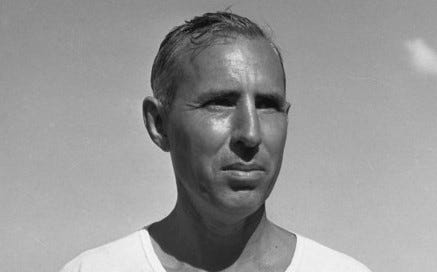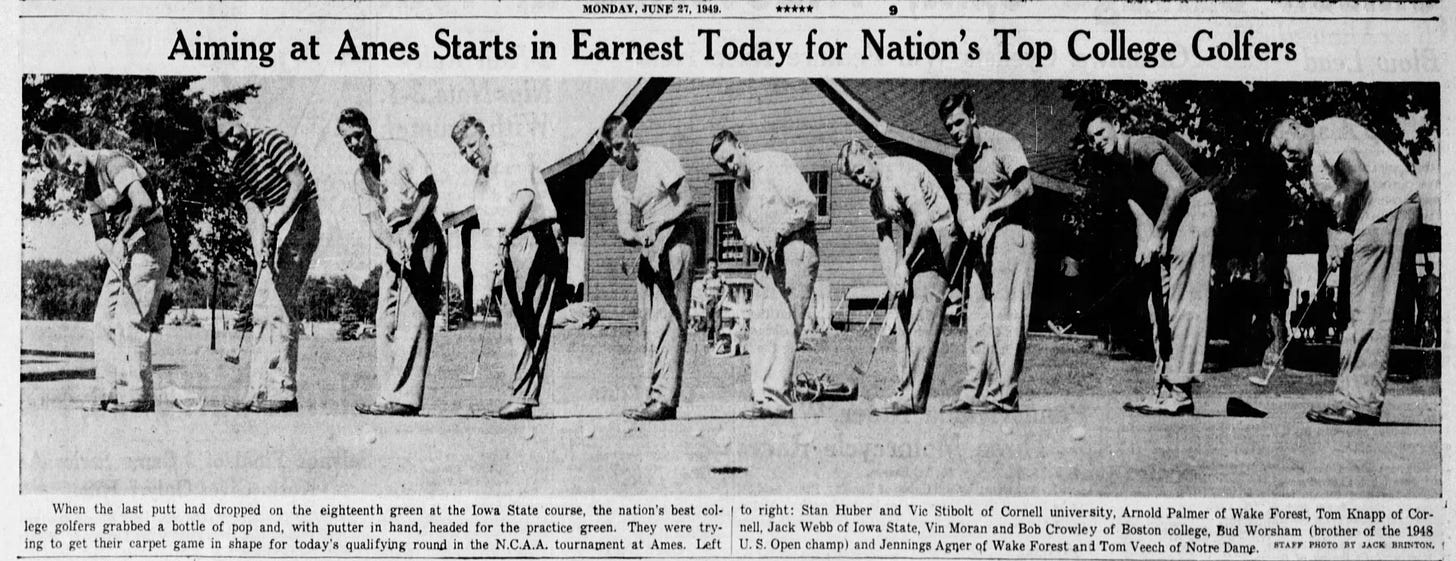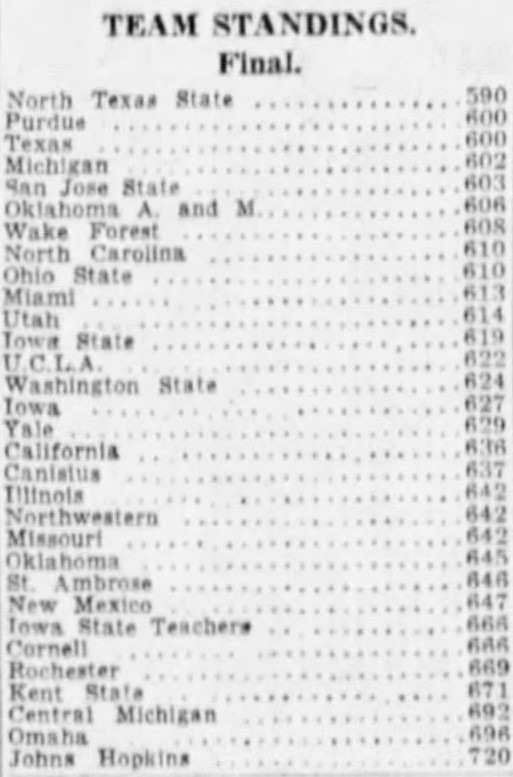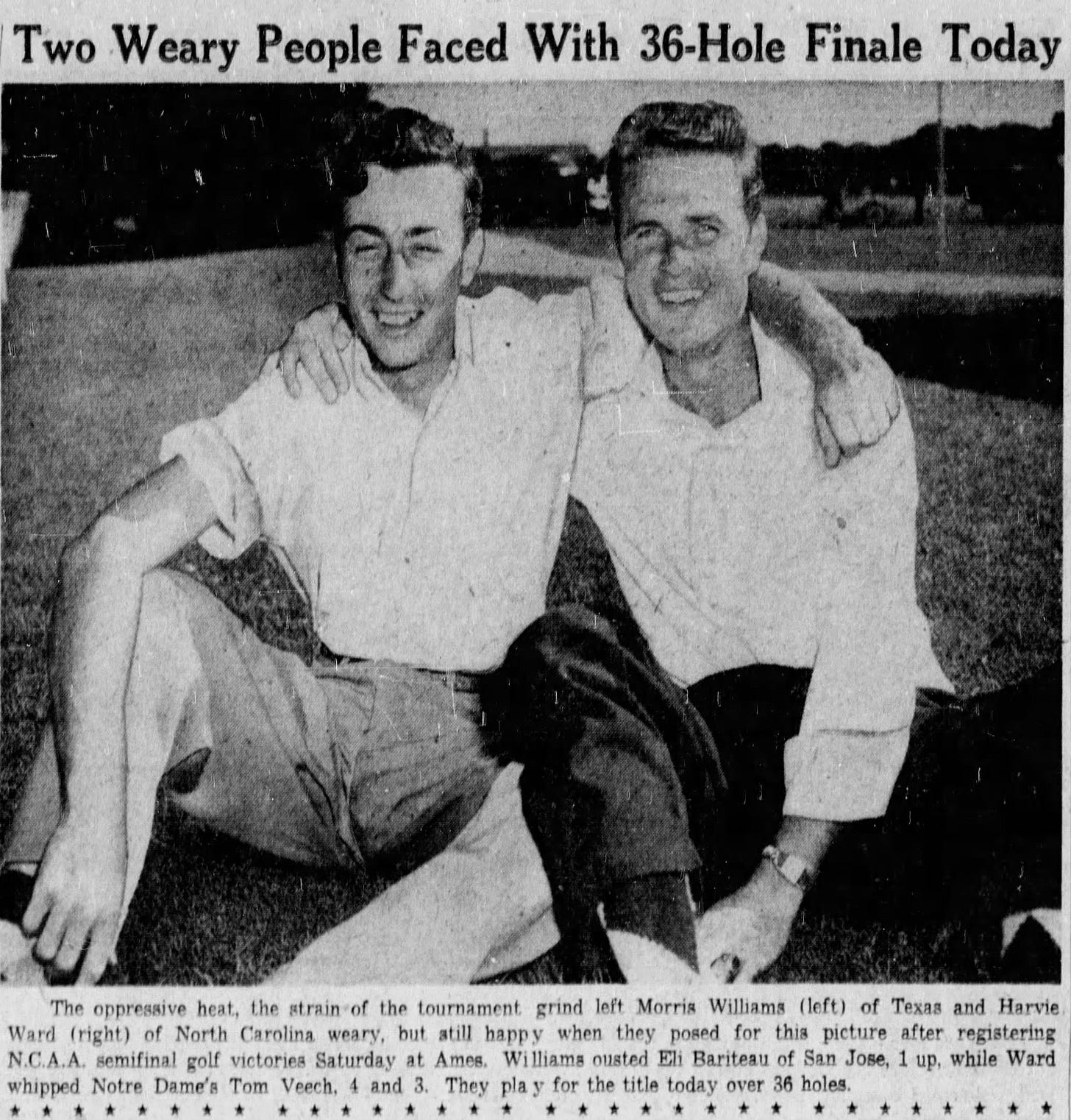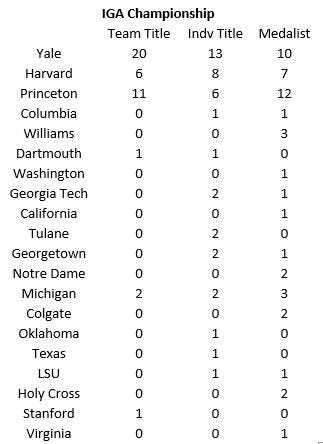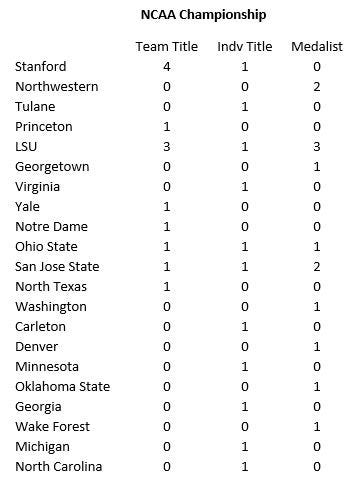This is part of a series on the Men’s Collegiate Championships
NCAA Championship Era: 1939-NOW
Following WWII, college golf experienced a similar boom in popularity as seen in other sports throughout the country. The next decade+ would see unprecedented growth bolstered by the fact that once again college golfers were winning major amateur tournaments while still in school. This era would give rise to a myriad of legendary players including many who are still revered today as some of the best to ever play the game. Although the tournament was now truly national and as diverse as ever, this also was the starting point of an interesting trend in a series of team dynasties, starting with North Texas (State).
Intercollegiate Championship #52: June 27-July 3, 1949
Host: Iowa State’s Course
Later renamed The Veenker Memorial course after the legendary Iowa State AD who helped bring it into being, the Perry Maxwell designed course opened in 1938 and was the perfect venue for the return of college golf to the state of Iowa ten years after the NCAA takeover of the tournament.
Format
Team stroke play
Day 1 = 18 holes
Day 2 = 18 holes
**6-count-4, doubles as the individual qualifier
Individual match play (64 players, random draw, 18 hole matches)
Results
Team Champ: North Texas State (1 NCAA, 1 overall)
Defending champs San Jose State came in as the perceived “mild favorite” so the team competition was largely wide open. At the end of the first day, North Texas State stood atop the field with a six shot lead, but there were numerous players who had yet to complete their first round thanks to a two hour rain delay. The weather continued to be an issue over the course of the tournament, but North Texas State held on to capture their first team title, placing their four counting scores T19 or better (5, T6, T11, T19).
Medalist: Arnold Palmer [Wake Forest]
Wake Forest’s superstar sophomore navigated the weather to put together a one-under par 141 for a one shot victory over Purdue’s Fred Wampler, the 1949 Big Ten individual co-champion (along with Michigan’s Ed Schalon) who would go on to win both the Big Ten individual title in 1950 as well as the NCAA individual championship. North Carolina’s Harvie Ward, another tournament favorite, followed up his first round 69 with a 74 to finish two shots back of Palmer. Iowa State captain Jack Webb was the highest finisher for the host team (T19) while Iowa’s Skip Carlson, who recently shot a record 65 on the same course, was disappointed to put together a pair of 76s that barely managed to qualify for match play.
Arnold Palmer would repeat as the NCAA medalist the next year - this time 2 strokes over Wampler - with a record-setting low 36-hole total of 138. Palmer and his Wake Forest team looked to be on the way towards an eventual championship when tragedy struck in the fall of 1950 when Buddy Warsham, one of the leaders of the Wake Forest team, was killed in an auto accident. The loss of his best friend devastated Palmer who left school to join the Coast Guard. Three years later, Palmer returned to Wake Forest for a single season, becoming the first ever ACC individual champion in 1954 (Wake Forest was one of 7 teams to leave the Southern Conference to establish the ACC in 1953) just a few months before winning the US Amateur and turning pro.
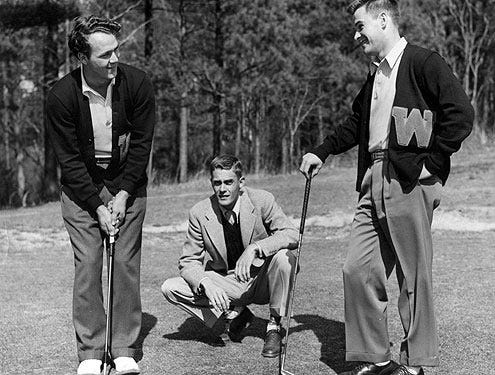
Palmer, Coach Johnston, and Buddy “Bud” Worsham (via Wake Forest athletics) Additional Fun Fact: Arnold Palmer was the Southern Conference individual champion in his freshman year (1948), beating out UNC’s Harvie Ward by a single stroke. Palmer would repeat the next year with a record low 36-hole score of 136. In 1950, Palmer led Wake Forest to their first Southern Conference team championship, but Ward kept Palmer from three-peating with a single stroke victory of his own.
Individual Champ: Harvie Ward [North Carolina]
Befitting the tournament, the weather seemed to be all over the place for the individual match play. Through the first 3 rounds it was almost as hot as Palmer’s play, but with his downfall in the Quarterfinals (to Notre Dame’s Tommy Veech) came a sudden rain and hail storm during the beginning of the Semifinal round on Friday afternoon, which filled the course with debris and delayed the tournament by a day. The next morning, Saturday, featured only the completion of the two Semifinals matches (18 holes), pushing the 36 hole Final to Sunday which gave finalists Harvie Ward [North Carolina] and Morris Williams Jr [Texas] some much needed rest. Ward defeated Williams in front of an estimated 1,000 spectators on a beautiful Sunday afternoon by a score of 5&4 to capture the university’s first NCAA golf title of any kind.
Harvie Ward and the USGA
We don’t have the space to get into all of Harvie Ward’s accomplishments during the 1940s and 1950s, however his British Amateur (1952), Canadian Amateur (1954), and US Amateur (1955 and 1956) trifecta puts him in ultra rarified territory as one of only two players (Richard Chapman) to win all three. Ward was a fearsome competitor who looked to be well on his way towards being the next Bobby Jones as he too was intent on remaining an amateur, but it all came crashing down in 1957. Like many career amateur golfers who did not come from a wealthy family, Ward found a benefactor who paid him a nice salary to essentially bankroll his golf “on the side.” For Harvie Ward, that benefactor was none other than Eddie Lowery - the famous boy-caddie for Francis Ouimet who won the 1913 US Open - an immensely successful car dealer in California whose tax deductions for paying Ward’s tournament expenses would ultimately cause the USGA to revoke his amateur status. Although the decision was reversed the next year and he was allowed to return to amateur golf, Harvie Ward was said to have never been the same competitor. He eventually settled in as a golf instructor at several well-known clubs and a later claim to fame was being Payne Stewart’s teacher for a time after Stewart’s father’s death. To this day, one of the most well known testaments to Harvie Ward’s prowess was his participation in “The Match” - which was captured in Mark Frost’s 2007 book by the same name - in which he and Ken Venturi teamed up as underdog amateurs to take on legendary pros Byron Nelson and Ben Hogan in a match for the ages.
Lasting Legacy of Morris Williams Jr
An Austin, Texas native and son of a prolific golf journalist, Morris Williams Jr quickly became a local legend after becoming the city’s youngest junior champion (age 13). He led the Texas team to Southwest conference championships in 1947, 1948, and 1950, as well as a University-best 2nd place finish at the 1949 NCAA championship. Following graduation in 1950, Williams served his country by joining the Air Force where he achieved the rank of Lieutenant as a pilot. William’s untimely death came in September 1953 as a result of an unfortunate training accident at Eglin AF Base (Florida) while piloting his F-86 jet. More of William’s incredible story can be read here and here. Not only was the Morris Williams Golf Course dedicated to his honor in 1963, a memorial tournament also bearing his name was starting in 1967 and was held each year by the University of Texas for 47 iterations until the final event in 2013. The list of individual champions of the tournament held in his memory is truly astounding, including: Hal Underwood, Ben Crenshaw, Payne Stewart, Fred Couples, Brian Watts, Bob Estes, Bob May, Phil Mickelson, Justin Leonard, Alan Bratton, Brad Elder, Bryce Molder, and Hunter Mahan.
Championship Award Count
COACHES CORNER: Fred Cobb [North Texas]

Former Georgia Tech and North Texas golfer (along with other sports), Fred Cobb became the North Texas coach following WWII and was instrumental in legitimizing the sport at the university. The first appearance by North Texas (then North Texas State) at the NCAA tournament came in 1947 when they finished 13th out of a record 39 teams. The next year they improved to finish 10th. To say that the run of the next four years - dominance not seen since Princeton in the 1920s - was unexpected would be an understatement:
1949 (Iowa State course)
As seen above, the first North Texas championship was well earned, but had it not been for the success seen over the next couple of years it might well have been considered just a fluke
1950 (New Mexico course)
North Texas held off a surging Purdue team led by (eventual) individual champion Fred Wampler to become only the second repeat team champion in the NCAA era
The core members of this team included Don January, Billy Maxwell, and Joe Conrad, who would lead the team for the next couple of years
1951 (Ohio State course)
The same North Texas team that made history the previous year once again defended their championship, becoming the first three-peat champion since Yale in the early 1930s
The one stroke victory over host Ohio State was as dramatic as it was close, with Don January clinching the championship with a 4-foot par put on the 18th to post a three-under 69
Interestingly, the top representative from the team that they beat - this time Ohio State’s Tom Nieporte - would go on to win the individual championship
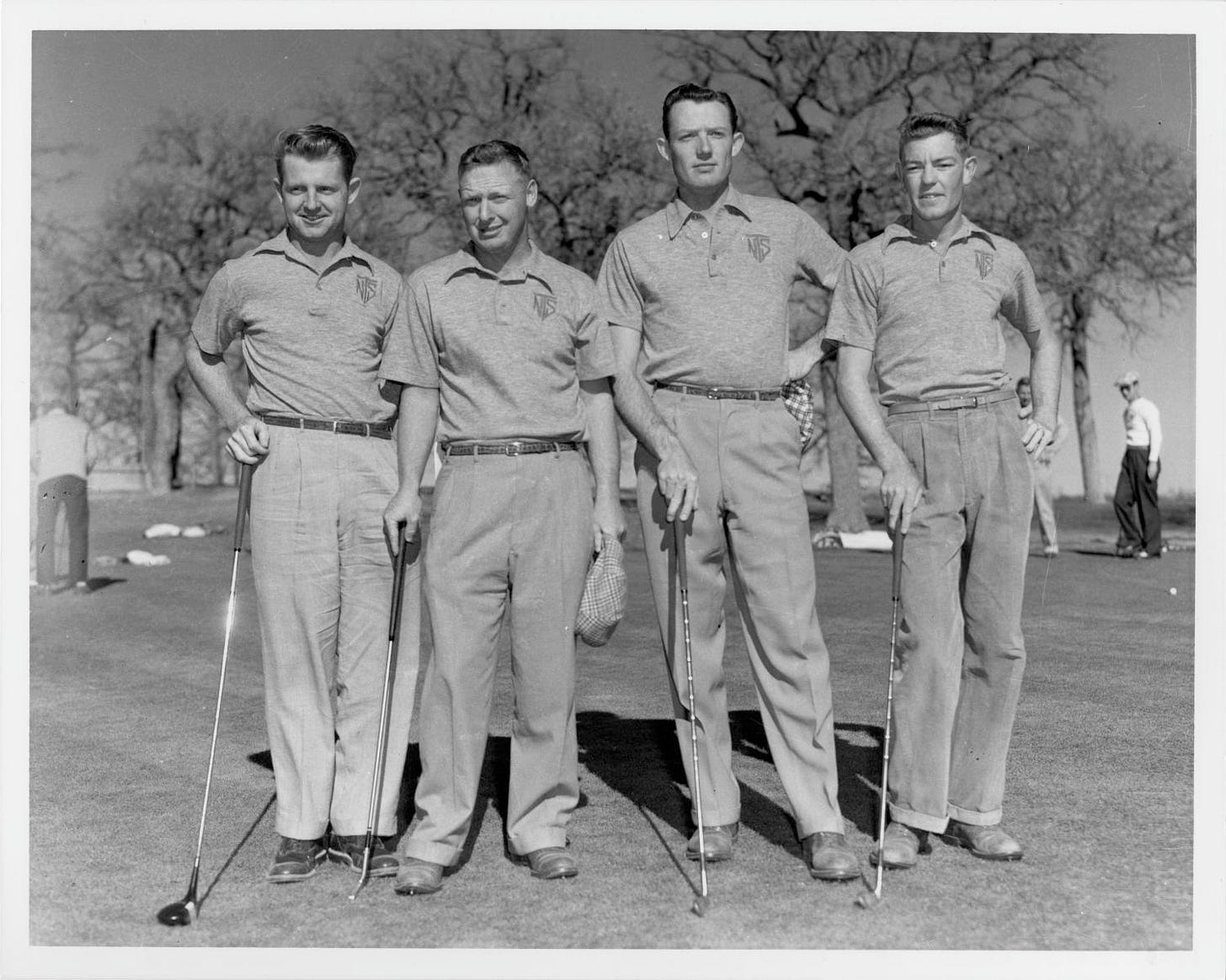
1951 Championship Team (via UNT)
1952 (Purdue course)
Now the unquestioned favorites, North Texas joined Yale and Princeton as the only teams to ever four-peat (only one other team has joined this list, which we will discuss in the next post)
The six-shot victory over Michigan and 11-shots over host Purdue was far less dramatic than in recent years

1952 Championship Team (via UNT)
1953 (Colorado course)
Cobb’s team was the perennial favorite and all but expected to capture their fifth title in a row
In March 1953, the USGA handed down a dramatic ruling that revoked the amateur status of basically all of the top UNT players: four for having expenses paid to a non-college event and two for essentially being paid to teach golf
With the likes of Byron Nelson speaking up for the collegians, the USGA eventually relented and reinstated most of the players’ amateur statuses with the notable exception of Don January who in later interviews stated his was never apologized to for the mistake and held a grudge against the USGA for the rest of his playing career.
Although the UNT team was able to recover from the events to win (another) Southern Intercollegiate championship in early May, they faltered in the NCAA championship a month later finishing 5th but only 5 shots back of Stanford
1954
There were high hopes for the 1953-1954 team to rekindle the magic of Cobb’s championship winning teams the previous four years
Tragedy struck in March when the 55 year old coach suffered a fatal heart attack
According to North Texas records, the legendary coach accumulated 72 team match victories with only 10 losses and 3 ties

Following Coach Cobb’s untimely death, Herb Ferrill took over head coaching duties - a position he would hold for the next 30 years. Although North Texas would not win another NCAA title, they did win 13 Missouri Valley Conference titles during Ferrill’s reign and in the years immediately following Cobb’s death they had the following finishes (starting in 1954): 2nd (by 1 stroke to SMU), 2nd (by 9 strokes to LSU), T2 (with Purdue, by 1 stroke to Houston), 3rd (by 4 strokes to Houston), 5th, 15th, T19, T7, 4th, and their last top5 finish being 3rd (by 4 strokes to Oklahoma State) in 1963. Both Coach Cobb and Coach Ferrill hold places of honor in the Golf Coaches Association of America Hall of Fame.
Thanks for reading!
Up Next:
In the next post we will cover the 1965 tournament which is a huge shift in determining individual champion by dropping the match play portion. This tournament falls squarely in the Dave Williams [Houston] era, which will be the major focus for this post. We have been looking forward to this one, hope you are too!

